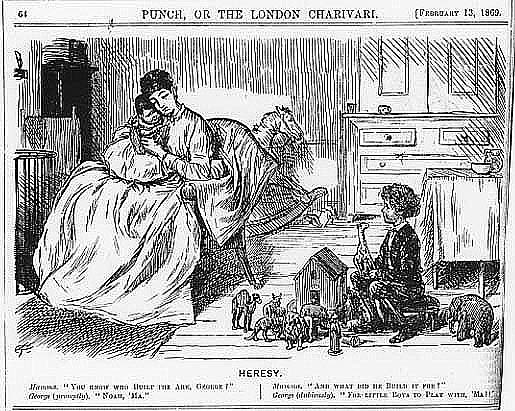
Punch LVI (February 13, 1869): 64

Punch LVI (February 13, 1869): 64
 arriage and motherhood were at the foundations of the
Victorian ideal of womanhood, and the manifestations of this
ideal appear frequently in Punch. "Heresy" of 1869 is one of the
many cartoons that depict the prototypical domestic scene: a
bourgeois household with a gentle mother and her children. In
this scene, Mamma calms the baby while attempting to coach the
precocious George in his Old Testament. Little George's
self-centered confusion over the story of Noah's ark is the
'heretical' punchline that lends the cartoon its cute humor.
arriage and motherhood were at the foundations of the
Victorian ideal of womanhood, and the manifestations of this
ideal appear frequently in Punch. "Heresy" of 1869 is one of the
many cartoons that depict the prototypical domestic scene: a
bourgeois household with a gentle mother and her children. In
this scene, Mamma calms the baby while attempting to coach the
precocious George in his Old Testament. Little George's
self-centered confusion over the story of Noah's ark is the
'heretical' punchline that lends the cartoon its cute humor.This Mamma, like so many who populate the pages of Punch, is the epitome of ladylike feminity. Her tranquil expression and serene happiness in the presence of her children is the defining element of her briefly-sketched personality. This Mamma is truly an 'angel in the house'. She is at the moral center of the home, as demonstrated by her quiet Scripture teaching. It is clear that she has succeeded in creating the comfortable and secure bastion of domestic peace that the Victorians idolized. The private sphere was the female domain; any education that the typical middle- or upper-class young woman would have had was intended to train her for her role as wife and mother, which was of grave importance. Until they reached the age of formal schooling, young boys -- the future men of politics and commerce -- were under the instruction and care of their mothers, and women bore the weight of a cultural imperative. As Sara Stickney Ellis, who wrote articles for the popular presses on manners and etiquette, advised her female readership in 1844, "You have deep responsibilities; you have urgent claims; a nation's moral worth is in your keeping."
The social ideal of motherhood was given further credence through the evidence of medicine. Motherhood was clearly defined as the biological norm as well as the social. Through the authority of popular science, most Victorians believed that unmarried spinsters were the women most susceptible to hysteria, a disease believed to be caused by the distress of an unused uterus. By thus defining what constituted deviant feminity, medical discourse further defined the normative ideal of a woman as one who fulfilled her reproductive function. The Mamma of "Heresy" represents much of what a Victorian woman was expected to be: the spirit of domestic tranquility, the vessel of motherhood, and the moral guide of her children.
[Victorian initial "M" by Harlan Wallach ©copyright 1994.]